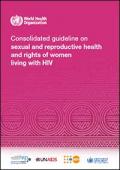Guidelines - Released in 2017
There were an estimated 17.8 million women aged 15 and older living with HIV in 2015, constituting 51% of all adults living with HIV. Adolescent girls and young women are particularly affected; in 2015 they constituted 60% of young people aged 15–24 years who were living with HIV, and they also accounted for 58% of newly acquired HIV infections among young persons in that age group. In many countries, women living with HIV do not have equitable access to good-quality health services and are also faced with multiple and intersecting forms of stigma and discrimination. Furthermore, women living with HIV are disproportionately vulnerable to violence, including violations of their sexual and reproductive rights.
This guideline is meant to help countries to more effectively and efficiently plan, develop and monitor programmes and services that promote gender equality and human rights and hence are more acceptable and appropriate for women living with HIV, taking into account the national and local epidemiological context. It discusses implementation issues that health interventions and service delivery must address to achieve gender equality and support human rights.
Downloads
Organizations
- World Health Organization (WHO)






